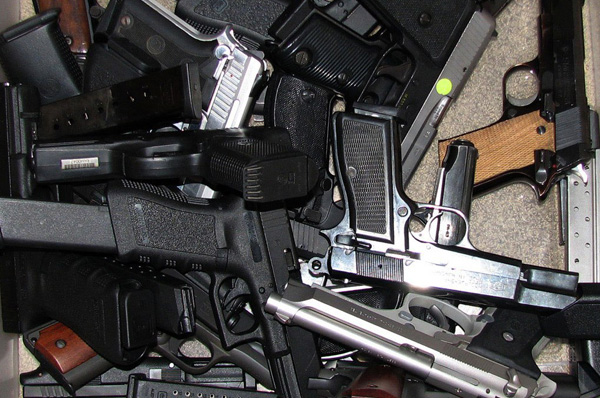
Photo by: DEA
With the growth in popularity of concealed carry, sales of pistols have soared. What’s more, the share of sales involving higher-caliber weapons has increased.
Shawn Dodson carries a gun in part because he doesn’t ever again want to have to defend himself with soup, as he did several years ago. He was at a grocery store with his family when he saw a fight break out. He intervened, angering one of the participants, who left the store and returned with a group of friends. “Next thing I know I have half a dozen guys in my face. The police were so slow to respond. I was about to get my ass kicked,” Dodson recalled. “I actually armed myself with a couple cans of soup.”
Nowadays Dodson, a Florida resident who used to hunt with his father and worked in military law enforcement during his time in the Navy, packs something more powerful than Progresso or Chunky. Like hundreds of thousands of Americans, he carries a concealed handgun. “I carry as often as I can,” Dodson says, “I don’t like to leave it in my car because I think that makes it vulnerable. To me it’s like a seatbelt. It’s like if you’re going to carry, you carry all the time.”
It’s hard to say whether Dodson is representative of the typical concealed carrier. It is, however, very easy to conclude that the ranks of people who pack heat are growing.
A City Limits survey of the 45 states that permit concealed carry (Illinois does not) and require a permit to do so (Alaska, Arizona, Vermont and Wyoming do not) finds the number of concealed carriers swelling—although differences in the manner and timing of reporting among states make it difficult to generate national statistics. Florida boats 956,000 permit holders, Utah some 380,000 and Washington 233,000. Other states report smaller totals but significant growth in their concealed carry population. New applications in Arkansas tripled from 2005 (4,800) to 2011 (16,000). Iowa saw the number of permits leap from 40,000 to 95,000 from 2010 to 2011. Ohio had 22,000 new issuances in 2007 and 50,000 last year.
Retailer surveys by the National Shooting Sports Foundation indicate that 25 percent of gun-store customers last year were first-time buyers and that those newcomers were most likely buying handguns which, unlike rifles or shotguns favored by hunters, are overwhelmingly bought for self-defense. That was up from 20 percent in 2010, perhaps reflecting concern—which the gun lobby has fed—that President Obama is plotting to radically restrict civilian access to firearms.
Ironically, some gun-rights supporters credit gun control laws for facilitating the concealed carry movement. The 1994 federal assault weapons ban limited how many bullets a gun magazine could hold. This impacted not just rifles but also handguns with large-capacity magazines. Forced to make smaller magazines, gun makers decided to make smaller guns.
The increasing popularity of concealed carry has reshaped the gun marketplace. The number of pistols manufactured in the U.S. has grown by an average of 19 percent over each of the past seven years.
But even as more Americans have been buying guns to hide in their waistband or on their ankle, more powerful handguns—those firing bullets .38 caliber or larger—increased their market share from 49 percent in 1989 to 73 percent in 2009.
Guns manufactured for domestic use or imported to the U.S., 1986-2011
Gun-rights groups credit gun-toting citizens with stopping thousands (by some questionable measures, millions) of crimes, figures that gun control groups strongly dispute. The NRA points to falling national crime rates as proof that increased concealed carry does not increase crime; needless to say, the association does not examine the possibility that decreasing crime might erode the rationale for carrying a self-defense weapon in the first place.
But as the Trayvon Martin killing illustrated, having an increasing number of citizens armed with increasingly powerful handguns can have tragic effects. Dodson runs a gun training school called Firearms Tactical that tries to create realistic scenarios for people learning how to handle their weapons. He emphasizes “high-stress” scenarios so each student “can recognize when the fight is on and you can take defensive measures to protect yourself.”
This is harder than it sounds. When an encounter suddenly takes on the potential for violent confrontation, physiological reactions can make mental decision-making difficult. Time slows down, tunnel vision kicks in and fine motor control can be hard to achieve. The latter is particularly troublesome for people carrying small but powerful handguns because, Dodson says, these guns recoil violently and can be very difficult to shoot accurately. He recommends that concealed carriers visit a range at least once a month to practice using their weapon, “So you don’t crumble under the moment.”
The people who visit Firearms Tactical for training do so voluntarily. Most states require a background check for a concealed carry permit, and some mandate a class in self-defense law, but as former NRA lobbyist Richard Feldman points out, “Texas is the only state that actually mandates that you get some training in the use of deadly force.” Feldman adds: “Most states, New York included, have no requirement that you learn shit from Shinola about the use of deadly force.”
Read our coverage of the effect of gun politics on the gun industry at The Nation.
Research support was provided by The Investigative Fund at the Nation Institute. Research assistance for this project was provided by Arielle Concilio.








